Phidget Control Panel: Difference between revisions
No edit summary |
No edit summary |
||
| (6 intermediate revisions by 2 users not shown) | |||
| Line 1: | Line 1: | ||
The | [[Category:Overview]] | ||
==Getting Started with the Phidget Control Panel== | |||
The Phidget Control Panel is a powerful tool that will help you develop your Phidgets applications. With the Phidget Control Panel, you can see any/all Phidgets that are attached to your machine (or a remote machine), update your Phidget's firmware, manage a Phidget Network Server, and more! | |||
If you are using a Windows machine, keep reading. If you are using a macOS machine, jump ahead to the [[#macOS|macOS section]]. | |||
==Windows== | ==Windows== | ||
If you haven't already, follow the [[OS_-_Windows#Getting started with Windows|getting started with Windows]] section on the Windows OS page. There you will install the Phidget libraries and learn how to open the Phidget Control Panel. | |||
===Phidgets tab=== | |||
After opening the Phidget Control Panel, you should see something like this: | |||
[[File:Windows ControlPanel General.PNG|link=|alt=Windows Control Panel General|center]] | |||
The Phidgets tab will list all Phidgets (and associated objects) that are connected to your machine, as well as the following information: | |||
*'''Serial number:''' allows you to differentiate between similar Phidgets. | |||
*'''Channel:''' allows you to differentiate between similar objects on a Phidget. | |||
*'''Version number:''' corresponds to the firmware version your Phidget is running. | |||
To add/remove information from the Phidget Control Panel, right-click on one of the column headers: | |||
[[File:Controlpanel_windows_showmore.png|link=|center]] | |||
[[File: | Every Phidget has an example program, double-click on a Phidget to run the program: | ||
[[File:RFIDReadWrite_Example.jpg|link=|alt=Windows Control Panel Example|center]] | |||
The | The screenshot above shows the example application for the 1024 - PhidgetRFID Read-Write. These examples are intended for demonstration and debugging purposes. | ||
[[File: | ====Setting a label==== | ||
Right-click on a Phidget to set a label. See [[Using_Multiple_Phidgets#Using_the_Label|using a label]] for more information about how to use labels with Phidgets. | |||
[[File:Controlpanel_windows_setlabel.png|link=|center]] | |||
====Updating Firmware==== | ====Updating Firmware==== | ||
If a Phidget shows up in red on the list in the Phidgets tab, it means the firmware is out of date: | |||
[[File:Controlpanel_windows_firmwareupgrade.png|link=|center]] | |||
Double click on the Phidget to be given an option to apply the update: | |||
[[File:Controlpanel_windows_firmwareupgrade_click.png|link=|center]] | |||
====Logging==== | ====Logging==== | ||
The Phidget Control Panel keeps a log file of all errors, warnings, and other | The Phidget Control Panel keeps a log file of all errors, warnings, and other information related to its operation. This information can be useful if you're having problems with your Phidgets, but you're not sure what's going wrong. To enable logging, first navigate to ''File'' -> ''Options...'' | ||
[[File:Controlpanel_windows_fileoptions.png|link=|center]] | |||
Next, check the box beside ''Enable Logging''. From the ''Level'' drop-down menu, you can select how detailed you want the output to be: | |||
[[File:Windows_ControlPanel_NetworkService_LogLevel.PNG|link=|alt=Windows Control Panel Network Server Setup|center]] | |||
*'''Info:''' default/recommended setting. Will log general information such as errors, attach/detach events, etc. | |||
*'''Error/Warning:''' will only log error messages/warning messages. Useful for keeping log files small in size. | |||
*'''Debug:''' for use with Debug version of library. | |||
*'''Critical:''' will only log critical messages (e.g. if program crashes) | |||
*'''Verbose:''' will log everything. Not recommended for normal use. | |||
To view the log files, click on ''Logs'' in the bottom right corner of the Phidget Control Panel. You can also find it by navigating to the following location: | |||
*C:/ProgramData/Phidgets/logs | |||
[[File: | [[File:Controlpanel_windows_loglocation.png|link=|alt=Windows Control Panel General|center]] | ||
===Network Server | There is a separate log file for each example, as well as the Network Server, to make it easier to find messages that are relevant to the part you're debugging. | ||
===Network Server tab=== | |||
To get started, click on the Network Server tab: | |||
[[File:Windows_ControlPanel_NetworkService_Setup_Stopped.jpg|link=|center|alt=Windows Control Panel Network Server Setup]] | |||
''Settings'' | |||
*'''Startup Type:''' determines when the Phidget Network Server will start. | |||
**'''Automatic:''' the Phidget Network Server will start automatically when Windows boots. | |||
**'''Manual:''' the Phidget Network Server will start only when you click the ''Start'' button at the bottom of the Window, or, if another service starts it. | |||
**'''Disabled:''' mode means the Phidget Network Server will stay off, regardless of what tries to start it. | |||
''Phidget Server Settings'' | |||
*'''Enabled:''' enable the Phidget server. When you enable the Phidget Server, other computer on the network will be able to access the Phidgets that are connected to your computer. | |||
*'''Publish:''' enable/disable mDNS. See the [[Phidget Network Server#Connecting to a Network Server|connecting to a Phidget Network Server]] for more information. | |||
*'''Server Name:''' your server name will allow you to identify your Phidget Server from others on the network. | |||
*'''Password (optional):''' prevent unauthorized computers on the network from accessing the Phidgets connected to your computer by setting a password. | |||
*'''Log Level:''' defaults to ''Info''. See [[#Logging|logging]] section above for more information. | |||
*'''Port:''' The port used by the Phidget Network Server (defaults to 5661). | |||
The | ''Webserver Settings'' | ||
*'''Enabled:''' enable the Webserver. The Webserver allows you to host a webpage that will have access to Phidgets through languages like [[Language_-_JavaScript|JavaScript]]. | |||
*'''Docroot:''' specifies the docroot path. This is where your webpage files will live and any/all additional libraries. | |||
*'''Port:''' The port used by the Webserver (defaults to 8989). | |||
''' | ''Dictionaries Settings'' | ||
*'''Enable User Dictionaries:''' in order to create/use a Phidget Dictionary with the Phidget Control Panel, make sure this setting is enabled. | |||
*'''Enable Monitoring/control Dictionary:''' by enabling this setting, you can view incoming/outgoing traffic related to your Phidget Network Server. Here is an example: | |||
[[File:Controlpanel_windows_servermonitoring.png|link=|center]] | |||
====Adding a Phidget Dictionary==== | |||
Phidget Dictionaries are an extremely powerful tool when working with Phidgets. See the [[Phidget Dictionary]] page for more information. | |||
Creating a Phidget Dictionary is quick and easy with the Phidget Control Panel. First specify a serial number for your Dictionary, and then give it a name (if you don't specify a serial number, a default will be provided). | |||
= | Next, click on the ''Config...'' button. Here you can create a key-value pair for your Dictionary: | ||
[[File:Controlpanel_windows_createdictionary.png|link=|center]] | |||
[[File: | After you create your key-value pair, make sure your Dictionary is enabled and then start your Phidget Network Server (or Restart, if it is already running). Navigate to the Phidgets tab and you will see your new Dictionary: | ||
[[File:Controlpanel_windows_dictionary.png|link=|center]] | |||
You can now access the Phidget Dictionary from any machine on the network. | |||
The | ===PhidgetSBCs Tab=== | ||
The last tab is the PhidgetSBCs tab, which displays the complete list of any PhidgetSBCs connected to the network: | |||
[[File:Phidgetsbc_windowscontrolpanel.PNG|link=|center]] | |||
Just like the Phidgets tab, you can right-click on any of the column headers for view options: | |||
[[File:Phidgetsbc_windowscontrolpanel_showmore.PNG|link=|center]] | |||
[[ | You can also double-click on a Phidget SBC to bring up the Phidget SBC Web Interface. The SBC Web Interface is covered in detail in the [[:Category:UserGuide | User Guide]] for your SBC. | ||
==macOS== | |||
If you haven't already, follow the [[OS_-_macOS#Getting started with macOS|getting started with macOS]] section on the macOS page. There you will install the Phidget libraries and learn how to open the Phidget Control Panel. | |||
===Phidgets Tab=== | ===Phidgets Tab=== | ||
After opening the Phidget Control Panel, you should see something like this: | |||
[[File:OSX ControlPanel General.png|link=|alt=macOS Control Panel General|center]] | |||
The Phidgets tab | The Phidgets tab will list all Phidgets (and associated objects) that are connected to your machine, as well as the following information: | ||
*'''Serial number:''' allows you to differentiate between similar Phidgets. | |||
*'''Channel:''' allows you to differentiate between similar objects on a Phidget. | |||
*'''Version number:''' corresponds to the firmware version your Phidget is running. | |||
Every Phidget has an example program, double-click on a Phidget to run the program: | |||
[[File:OSX Control Panel Channel.png |link=|alt=macOS Control Panel Channel|center]] | |||
The screenshot above shows the example application for the 1024 - PhidgetRFID Read-Write. These examples are intended for demonstration and debugging purposes. | |||
====Updating Firmware==== | ====Updating Firmware==== | ||
If a Phidget shows up in red on the list in the Phidgets tab, it means the firmware is out of date. Double click on the Phidget to be given an option to apply the update. If you choose not to update, you can still use the control panel example afterwards. | |||
====Logging==== | |||
The Phidget Control Panel keeps a log file of all errors, warnings, and other information related to its operation. This information can be useful if you're having problems with your Phidgets, but you're not sure what's going wrong. To view the log file, open the ''Console'' application under ''Applications'' -> ''Utilities'' | |||
[[File:Controlpanel_mac_console.png|900px|link=|center]] | |||
After opening the ''Console'' application, navigate to user logs (''~/Library/Logs'') on the left menu. You will likely have a list of logs from various applications. After finding the Phidget logs, you will see something like this: | |||
[[File:Controlpanel_mac_log.png|link=|center]] | |||
===Network Server Tab=== | ===Network Server Tab=== | ||
To get started, click on the Network Server tab: | |||
[[File:Macos_networkserver.png|link=|center]] | |||
The | ''Settings'' | ||
*'''Start Network Server''': start or stop the Network Server. The text to the right of the button will display the current status of the Network Server. | |||
*'''Start Automatically on Boot''': the Network Server will start automatically when the computer boots. Otherwise, you'll have to manually start the Network Server every time you want to use it. | |||
''' | ''Phidget Server Settings'' | ||
*'''Enabled:''' enable the Phidget server. When you enable the Phidget Server, other computer on the network will be able to access the Phidgets that are connected to your computer. | |||
*'''Publish:''' enable/disable mDNS. See the [[Phidget Network Server#Connecting to a Network Server|connecting to a Phidget Network Server]] for more information. | |||
*'''Server Name:''' your server name will allow you to identify your Phidget Server from others on the network. | |||
*'''Password (optional):''' prevent unauthorized computers on the network from accessing the Phidgets connected to your computer by setting a password. | |||
*'''Port:''' The port used by the Phidget Network Server (defaults to 5661). | |||
''' | ''Webserver Settings'' | ||
*'''Enabled:''' enable the Webserver. The Webserver allows you to host a webpage that will have access to Phidgets through languages like [[Language_-_JavaScript|JavaScript]]. | |||
*'''Docroot:''' specifies the docroot path. This is where your webpage files will live and any/all additional libraries. | |||
*'''Port:''' The port used by the Webserver (defaults to 8989). | |||
''' | ''Dictionaries Settings'' | ||
*'''Enable User Dictionaries:''' in order to create/use a Phidget Dictionary with the Phidget Control Panel, make sure this setting is enabled. | |||
*'''Enable Monitoring/control Dictionary:''' by enabling this setting, you can view incoming/outgoing traffic related to your Phidget Network Server. Currently you can view this information on a Windows machine only. | |||
====Adding a Phidget Dictionary==== | |||
Phidget Dictionaries are an extremely powerful tool when working with Phidgets. See the [[Phidget Dictionary]] page for more information. | |||
Creating a Phidget Dictionary is quick and easy with the Phidget Control Panel. Simply press the '''+''' button and specify a name and serial number for your Dictionary: | |||
[[File:Controlpanel_macos_createdictionary.png|link=|center]] | |||
Next, make sure your Dictionary is enabled and then start your Phidget Network Server (or Restart, if it is already running). Navigate to the Phidgets tab and you will see your new Dictionary: | |||
[[File:Contorlpanel_macos_dictionary.png|link=|center]] | |||
You can now access the Phidget Dictionary from any machine on the network. | |||
===PhidgetSBC Tab=== | |||
The last tab is the PhidgetSBCs tab, which displays the complete list of PhidgetSBCs connected to the network. | |||
[[File:Phidgetsbc_maccontrolpanel.png|link=|center]] | |||
You can double-click on a Phidget SBC to bring up the Phidget SBC Web Interface. The SBC Web Interface is covered in the [[:Category:UserGuide | User Guide]] for your SBC. | |||
==Linux== | ==Linux== | ||
There is no graphical interface like the control panel on Linux. | There is no graphical interface like the control panel on Linux. | ||
See the [[OS - Linux]] page for more information on how to get started with Phidgets on Linux. | See the [[OS - Linux]] page for more information on how to get started with Phidgets on Linux. | ||
Revision as of 01:00, 23 June 2017
Getting Started with the Phidget Control Panel
The Phidget Control Panel is a powerful tool that will help you develop your Phidgets applications. With the Phidget Control Panel, you can see any/all Phidgets that are attached to your machine (or a remote machine), update your Phidget's firmware, manage a Phidget Network Server, and more!
If you are using a Windows machine, keep reading. If you are using a macOS machine, jump ahead to the macOS section.
Windows
If you haven't already, follow the getting started with Windows section on the Windows OS page. There you will install the Phidget libraries and learn how to open the Phidget Control Panel.
Phidgets tab
After opening the Phidget Control Panel, you should see something like this:
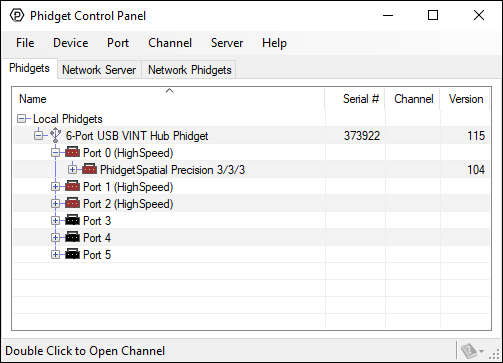
The Phidgets tab will list all Phidgets (and associated objects) that are connected to your machine, as well as the following information:
- Serial number: allows you to differentiate between similar Phidgets.
- Channel: allows you to differentiate between similar objects on a Phidget.
- Version number: corresponds to the firmware version your Phidget is running.
To add/remove information from the Phidget Control Panel, right-click on one of the column headers:
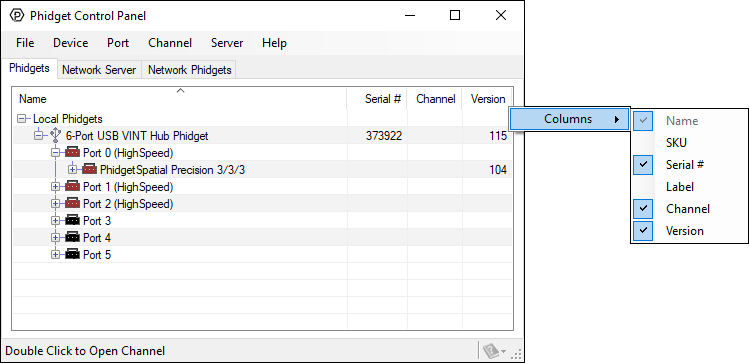
Every Phidget has an example program, double-click on a Phidget to run the program:
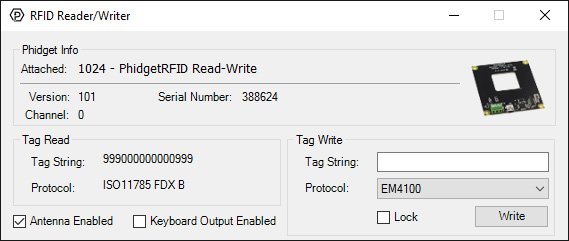
The screenshot above shows the example application for the 1024 - PhidgetRFID Read-Write. These examples are intended for demonstration and debugging purposes.
Setting a label
Right-click on a Phidget to set a label. See using a label for more information about how to use labels with Phidgets.
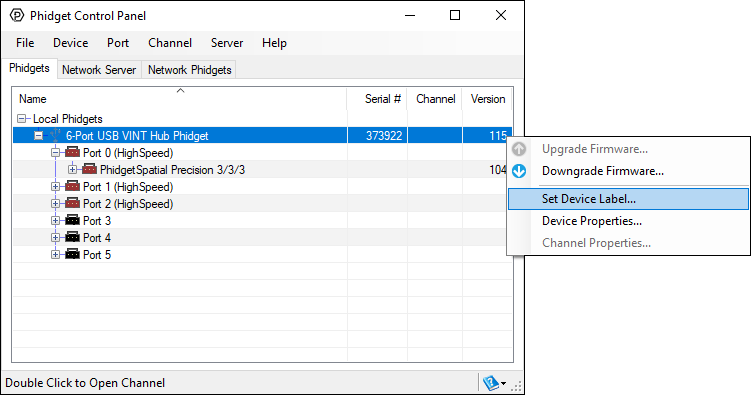
Updating Firmware
If a Phidget shows up in red on the list in the Phidgets tab, it means the firmware is out of date:

Double click on the Phidget to be given an option to apply the update:
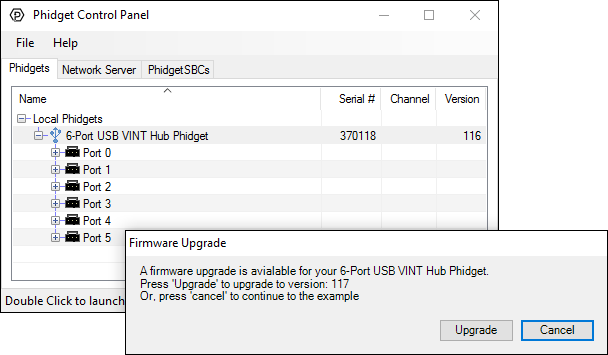
Logging
The Phidget Control Panel keeps a log file of all errors, warnings, and other information related to its operation. This information can be useful if you're having problems with your Phidgets, but you're not sure what's going wrong. To enable logging, first navigate to File -> Options...
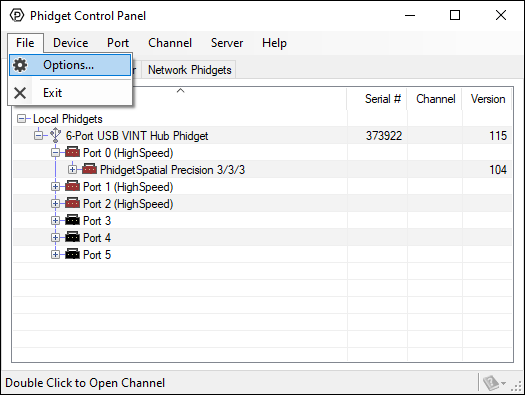
Next, check the box beside Enable Logging. From the Level drop-down menu, you can select how detailed you want the output to be:
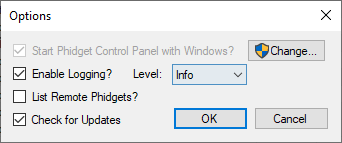
- Info: default/recommended setting. Will log general information such as errors, attach/detach events, etc.
- Error/Warning: will only log error messages/warning messages. Useful for keeping log files small in size.
- Debug: for use with Debug version of library.
- Critical: will only log critical messages (e.g. if program crashes)
- Verbose: will log everything. Not recommended for normal use.
To view the log files, click on Logs in the bottom right corner of the Phidget Control Panel. You can also find it by navigating to the following location:
- C:/ProgramData/Phidgets/logs

There is a separate log file for each example, as well as the Network Server, to make it easier to find messages that are relevant to the part you're debugging.
Network Server tab
To get started, click on the Network Server tab:

Settings
- Startup Type: determines when the Phidget Network Server will start.
- Automatic: the Phidget Network Server will start automatically when Windows boots.
- Manual: the Phidget Network Server will start only when you click the Start button at the bottom of the Window, or, if another service starts it.
- Disabled: mode means the Phidget Network Server will stay off, regardless of what tries to start it.
Phidget Server Settings
- Enabled: enable the Phidget server. When you enable the Phidget Server, other computer on the network will be able to access the Phidgets that are connected to your computer.
- Publish: enable/disable mDNS. See the connecting to a Phidget Network Server for more information.
- Server Name: your server name will allow you to identify your Phidget Server from others on the network.
- Password (optional): prevent unauthorized computers on the network from accessing the Phidgets connected to your computer by setting a password.
- Log Level: defaults to Info. See logging section above for more information.
- Port: The port used by the Phidget Network Server (defaults to 5661).
Webserver Settings
- Enabled: enable the Webserver. The Webserver allows you to host a webpage that will have access to Phidgets through languages like JavaScript.
- Docroot: specifies the docroot path. This is where your webpage files will live and any/all additional libraries.
- Port: The port used by the Webserver (defaults to 8989).
Dictionaries Settings
- Enable User Dictionaries: in order to create/use a Phidget Dictionary with the Phidget Control Panel, make sure this setting is enabled.
- Enable Monitoring/control Dictionary: by enabling this setting, you can view incoming/outgoing traffic related to your Phidget Network Server. Here is an example:
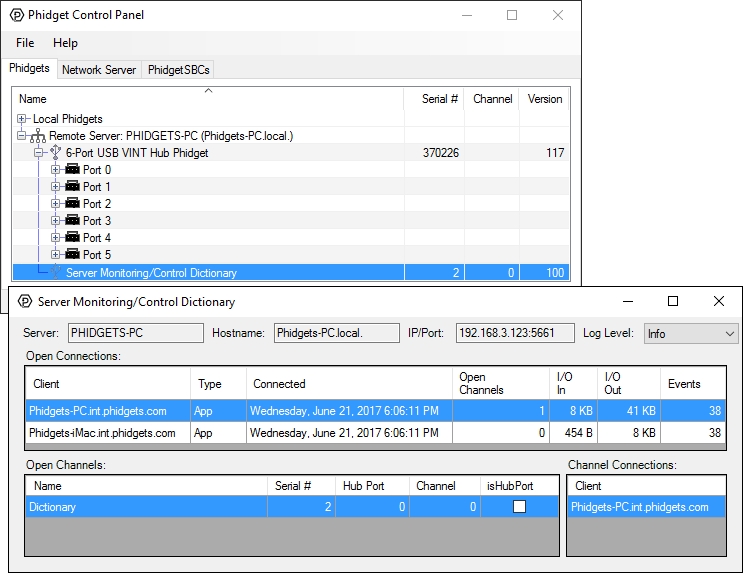
Adding a Phidget Dictionary
Phidget Dictionaries are an extremely powerful tool when working with Phidgets. See the Phidget Dictionary page for more information.
Creating a Phidget Dictionary is quick and easy with the Phidget Control Panel. First specify a serial number for your Dictionary, and then give it a name (if you don't specify a serial number, a default will be provided).
Next, click on the Config... button. Here you can create a key-value pair for your Dictionary:
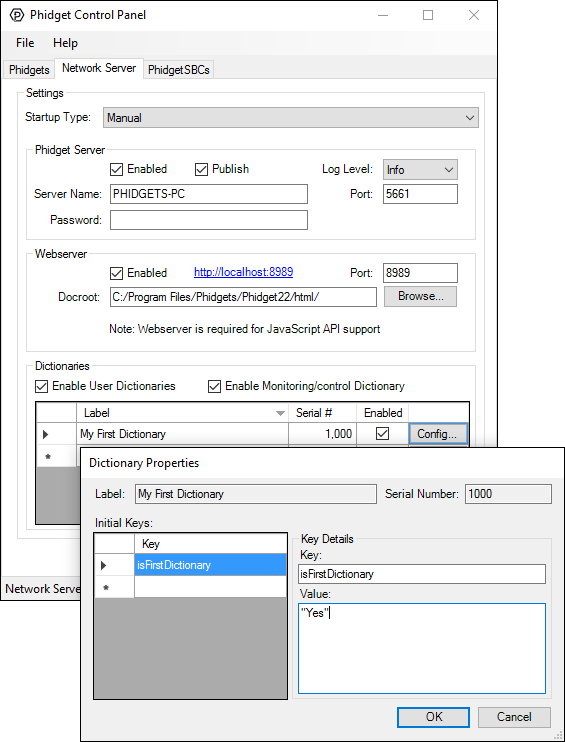
After you create your key-value pair, make sure your Dictionary is enabled and then start your Phidget Network Server (or Restart, if it is already running). Navigate to the Phidgets tab and you will see your new Dictionary:
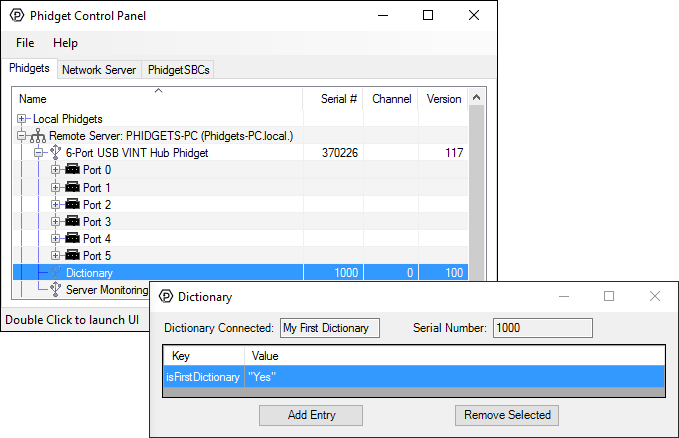
You can now access the Phidget Dictionary from any machine on the network.
PhidgetSBCs Tab
The last tab is the PhidgetSBCs tab, which displays the complete list of any PhidgetSBCs connected to the network:

Just like the Phidgets tab, you can right-click on any of the column headers for view options:
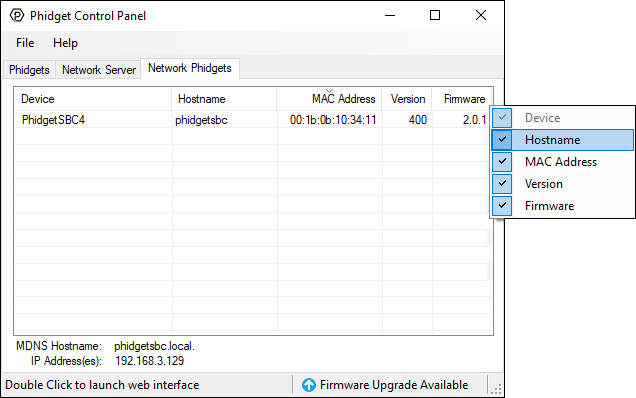
You can also double-click on a Phidget SBC to bring up the Phidget SBC Web Interface. The SBC Web Interface is covered in detail in the User Guide for your SBC.
macOS
If you haven't already, follow the getting started with macOS section on the macOS page. There you will install the Phidget libraries and learn how to open the Phidget Control Panel.
Phidgets Tab
After opening the Phidget Control Panel, you should see something like this:
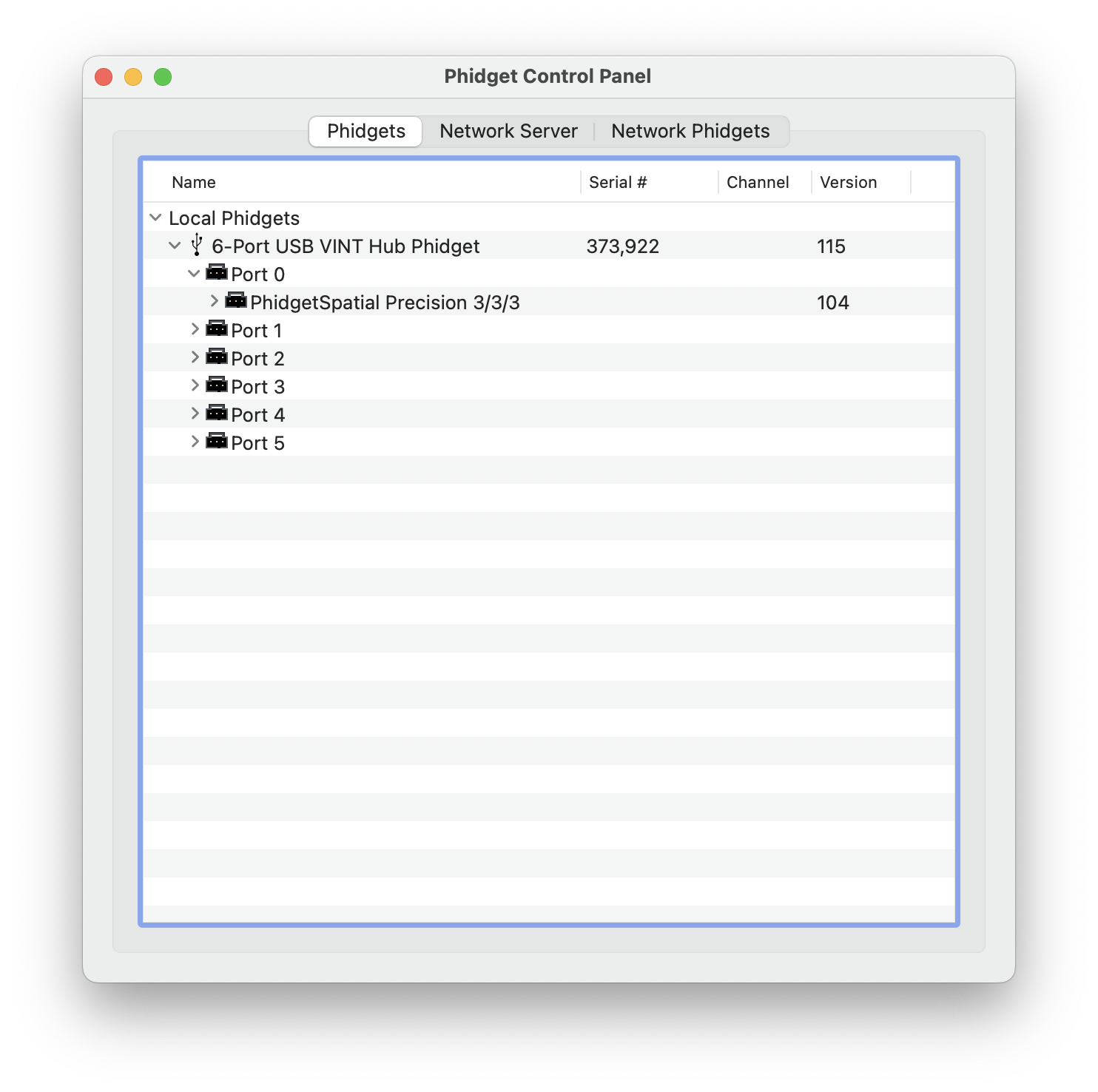
The Phidgets tab will list all Phidgets (and associated objects) that are connected to your machine, as well as the following information:
- Serial number: allows you to differentiate between similar Phidgets.
- Channel: allows you to differentiate between similar objects on a Phidget.
- Version number: corresponds to the firmware version your Phidget is running.
Every Phidget has an example program, double-click on a Phidget to run the program:
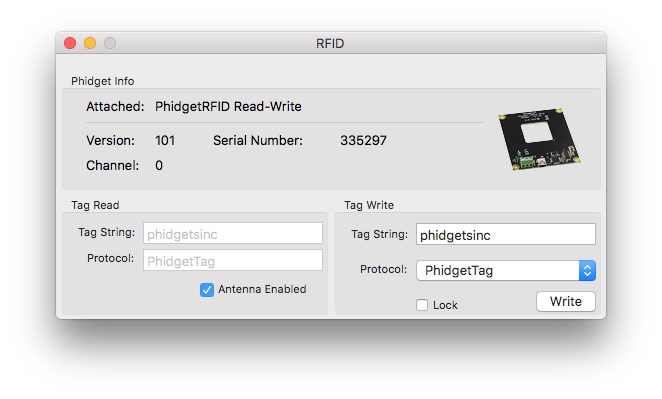
The screenshot above shows the example application for the 1024 - PhidgetRFID Read-Write. These examples are intended for demonstration and debugging purposes.
Updating Firmware
If a Phidget shows up in red on the list in the Phidgets tab, it means the firmware is out of date. Double click on the Phidget to be given an option to apply the update. If you choose not to update, you can still use the control panel example afterwards.
Logging
The Phidget Control Panel keeps a log file of all errors, warnings, and other information related to its operation. This information can be useful if you're having problems with your Phidgets, but you're not sure what's going wrong. To view the log file, open the Console application under Applications -> Utilities
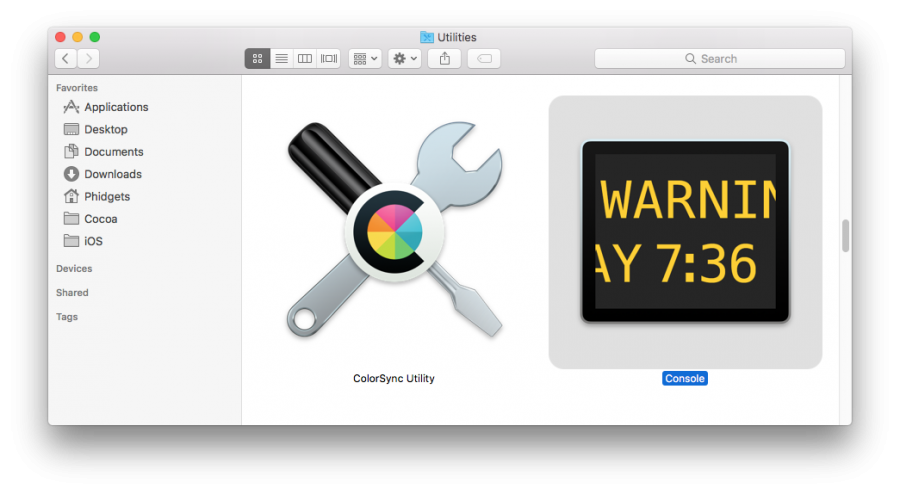
After opening the Console application, navigate to user logs (~/Library/Logs) on the left menu. You will likely have a list of logs from various applications. After finding the Phidget logs, you will see something like this:
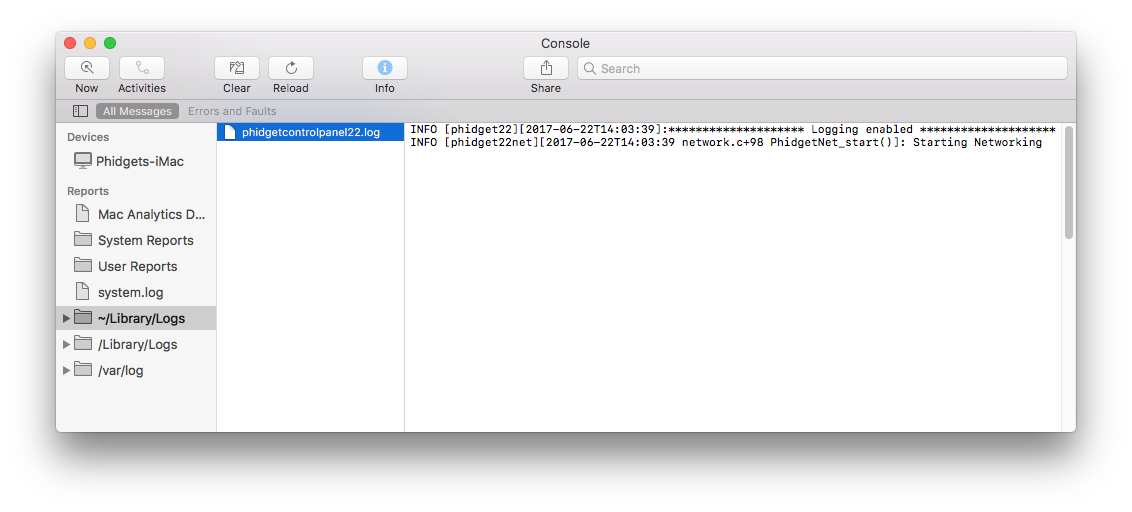
Network Server Tab
To get started, click on the Network Server tab:
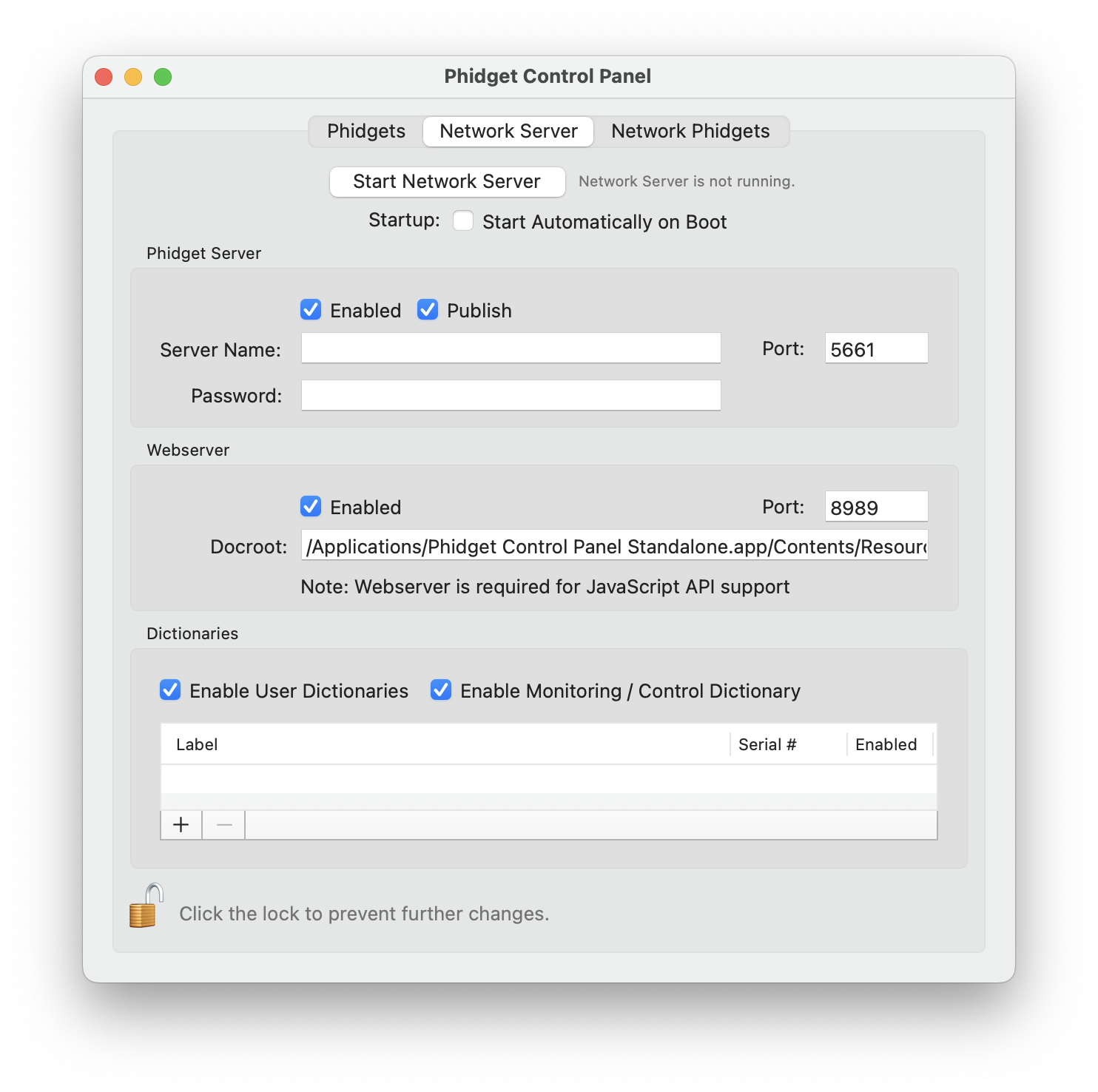
Settings
- Start Network Server: start or stop the Network Server. The text to the right of the button will display the current status of the Network Server.
- Start Automatically on Boot: the Network Server will start automatically when the computer boots. Otherwise, you'll have to manually start the Network Server every time you want to use it.
Phidget Server Settings
- Enabled: enable the Phidget server. When you enable the Phidget Server, other computer on the network will be able to access the Phidgets that are connected to your computer.
- Publish: enable/disable mDNS. See the connecting to a Phidget Network Server for more information.
- Server Name: your server name will allow you to identify your Phidget Server from others on the network.
- Password (optional): prevent unauthorized computers on the network from accessing the Phidgets connected to your computer by setting a password.
- Port: The port used by the Phidget Network Server (defaults to 5661).
Webserver Settings
- Enabled: enable the Webserver. The Webserver allows you to host a webpage that will have access to Phidgets through languages like JavaScript.
- Docroot: specifies the docroot path. This is where your webpage files will live and any/all additional libraries.
- Port: The port used by the Webserver (defaults to 8989).
Dictionaries Settings
- Enable User Dictionaries: in order to create/use a Phidget Dictionary with the Phidget Control Panel, make sure this setting is enabled.
- Enable Monitoring/control Dictionary: by enabling this setting, you can view incoming/outgoing traffic related to your Phidget Network Server. Currently you can view this information on a Windows machine only.
Adding a Phidget Dictionary
Phidget Dictionaries are an extremely powerful tool when working with Phidgets. See the Phidget Dictionary page for more information.
Creating a Phidget Dictionary is quick and easy with the Phidget Control Panel. Simply press the + button and specify a name and serial number for your Dictionary:
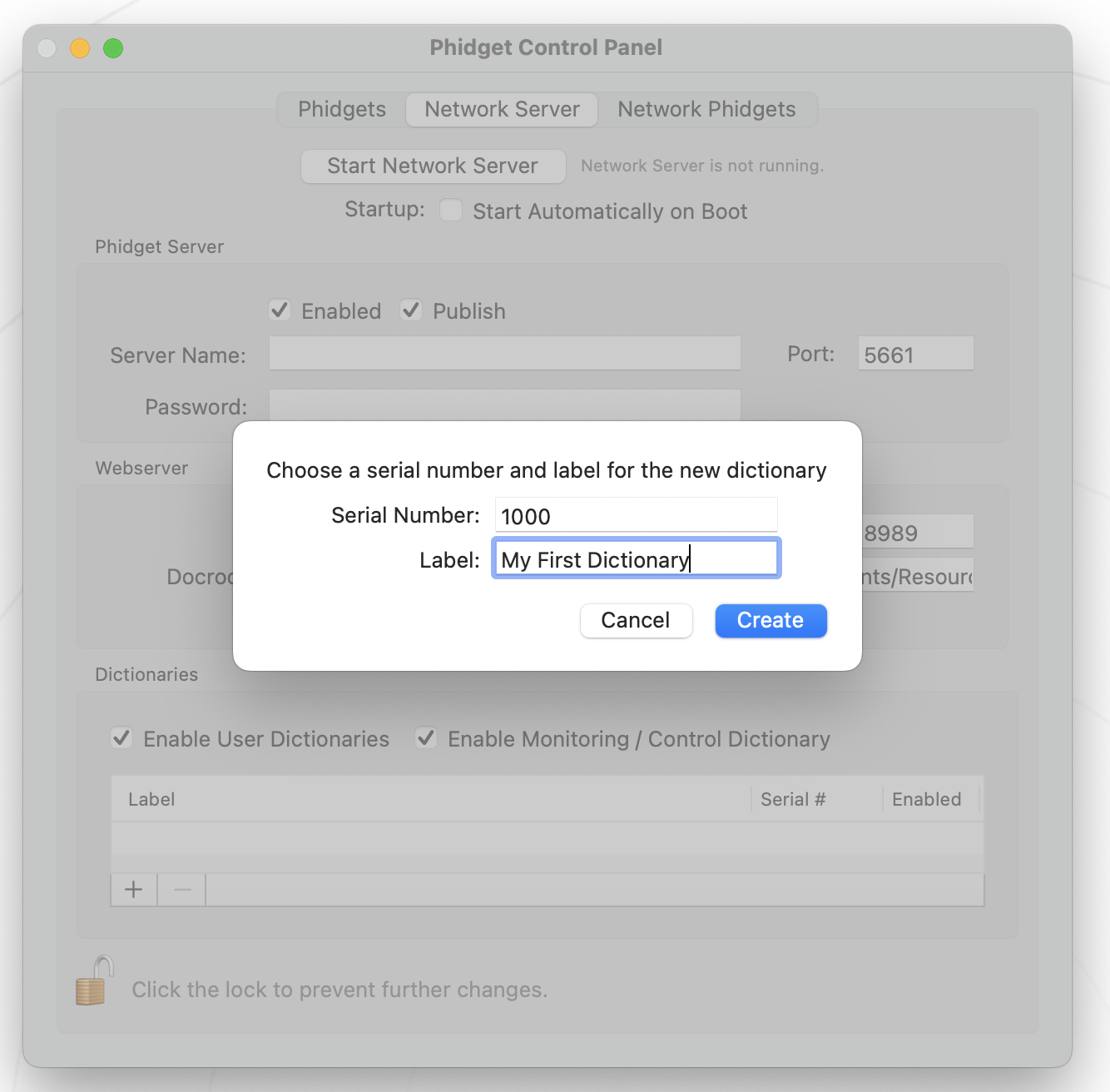
Next, make sure your Dictionary is enabled and then start your Phidget Network Server (or Restart, if it is already running). Navigate to the Phidgets tab and you will see your new Dictionary:

You can now access the Phidget Dictionary from any machine on the network.
PhidgetSBC Tab
The last tab is the PhidgetSBCs tab, which displays the complete list of PhidgetSBCs connected to the network.

You can double-click on a Phidget SBC to bring up the Phidget SBC Web Interface. The SBC Web Interface is covered in the User Guide for your SBC.
Linux
There is no graphical interface like the control panel on Linux. See the OS - Linux page for more information on how to get started with Phidgets on Linux.
